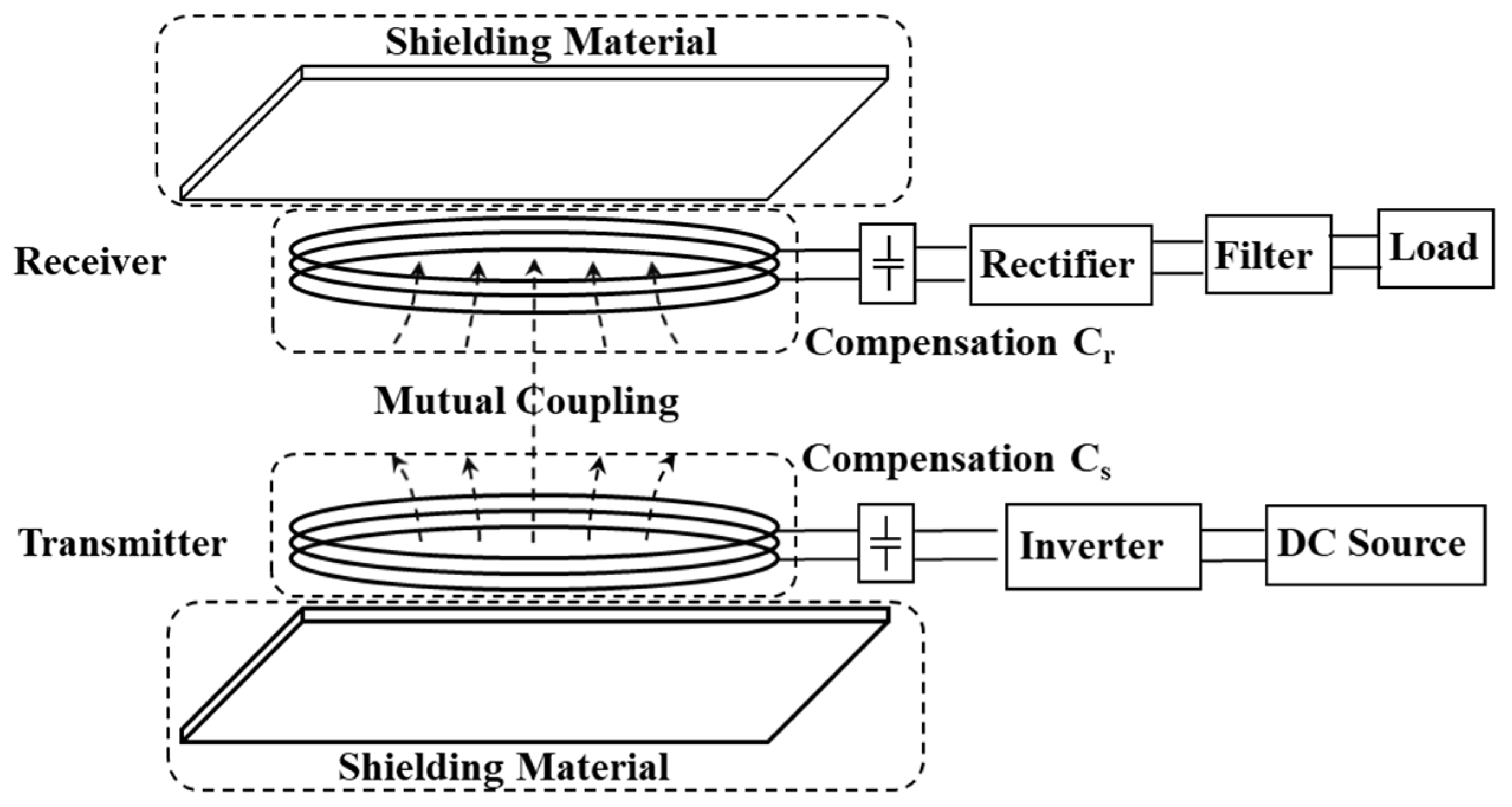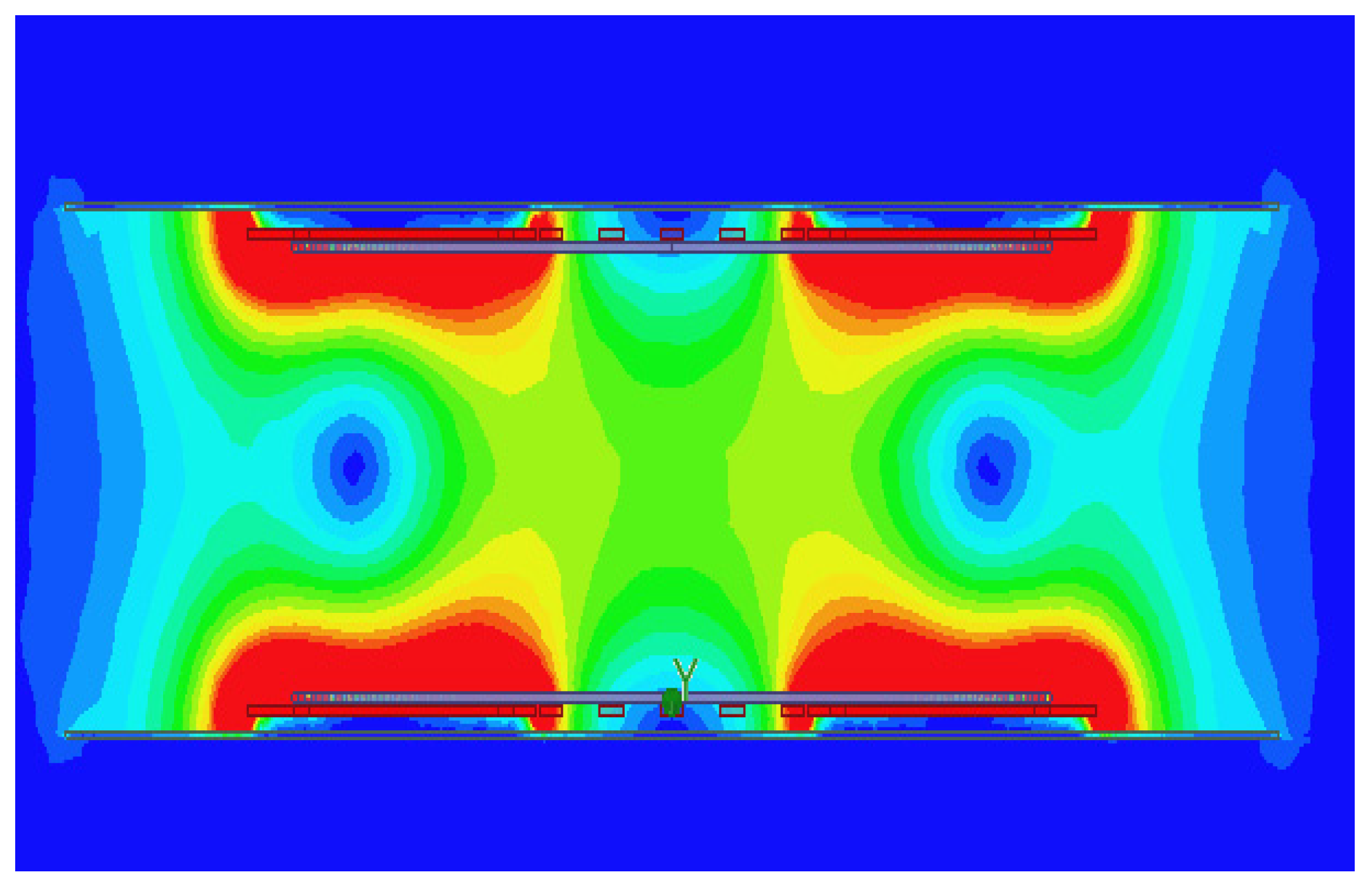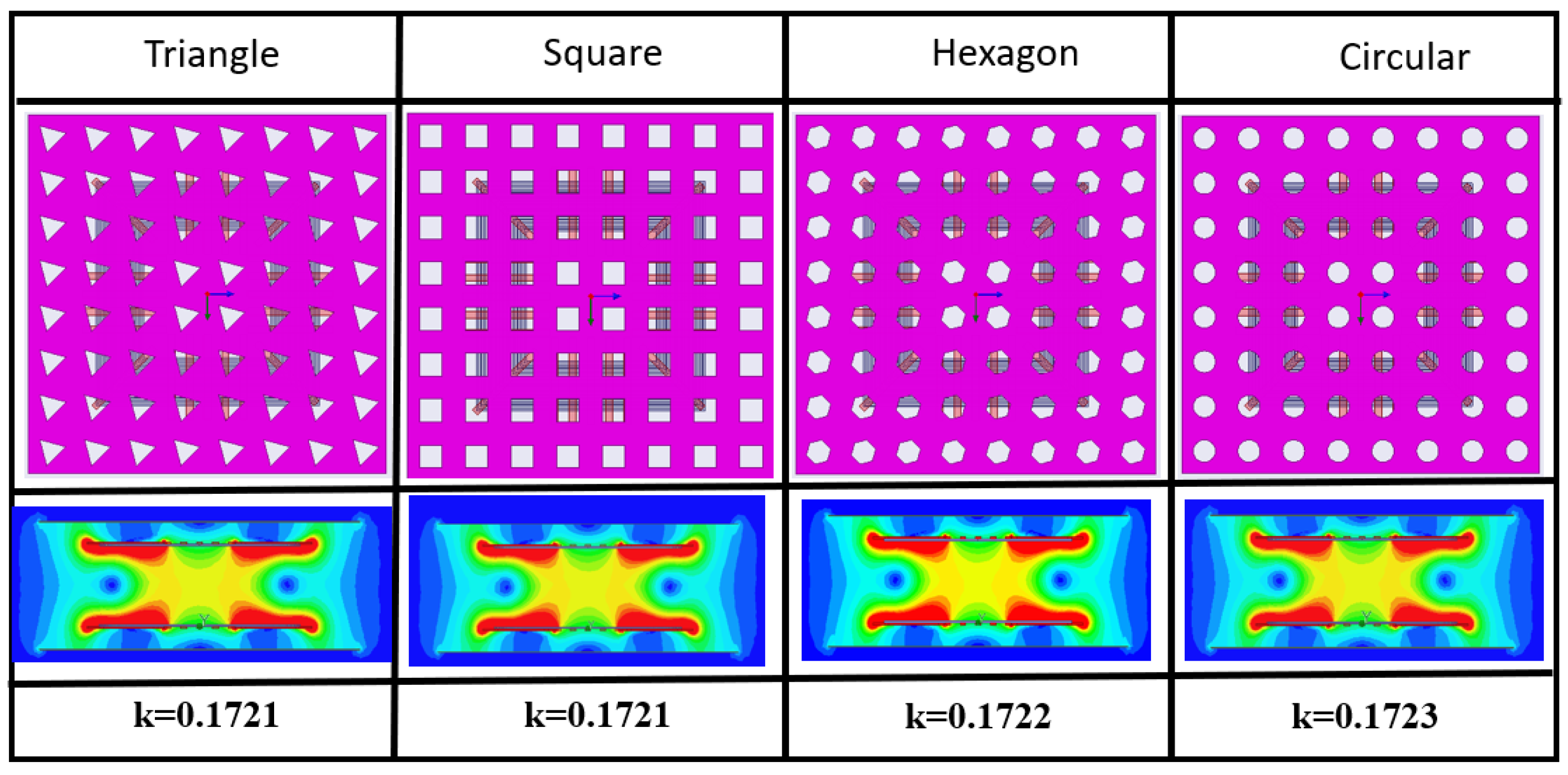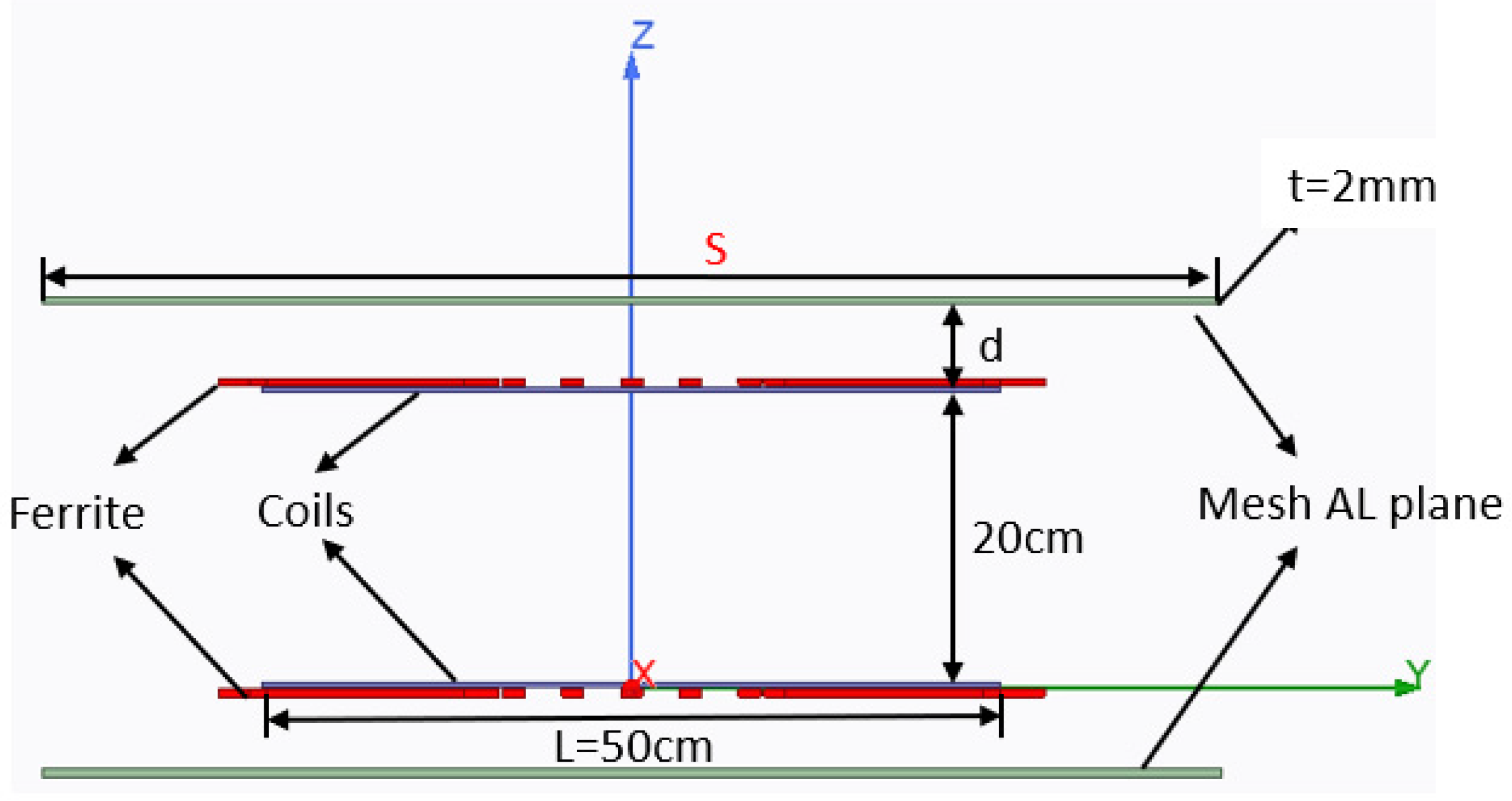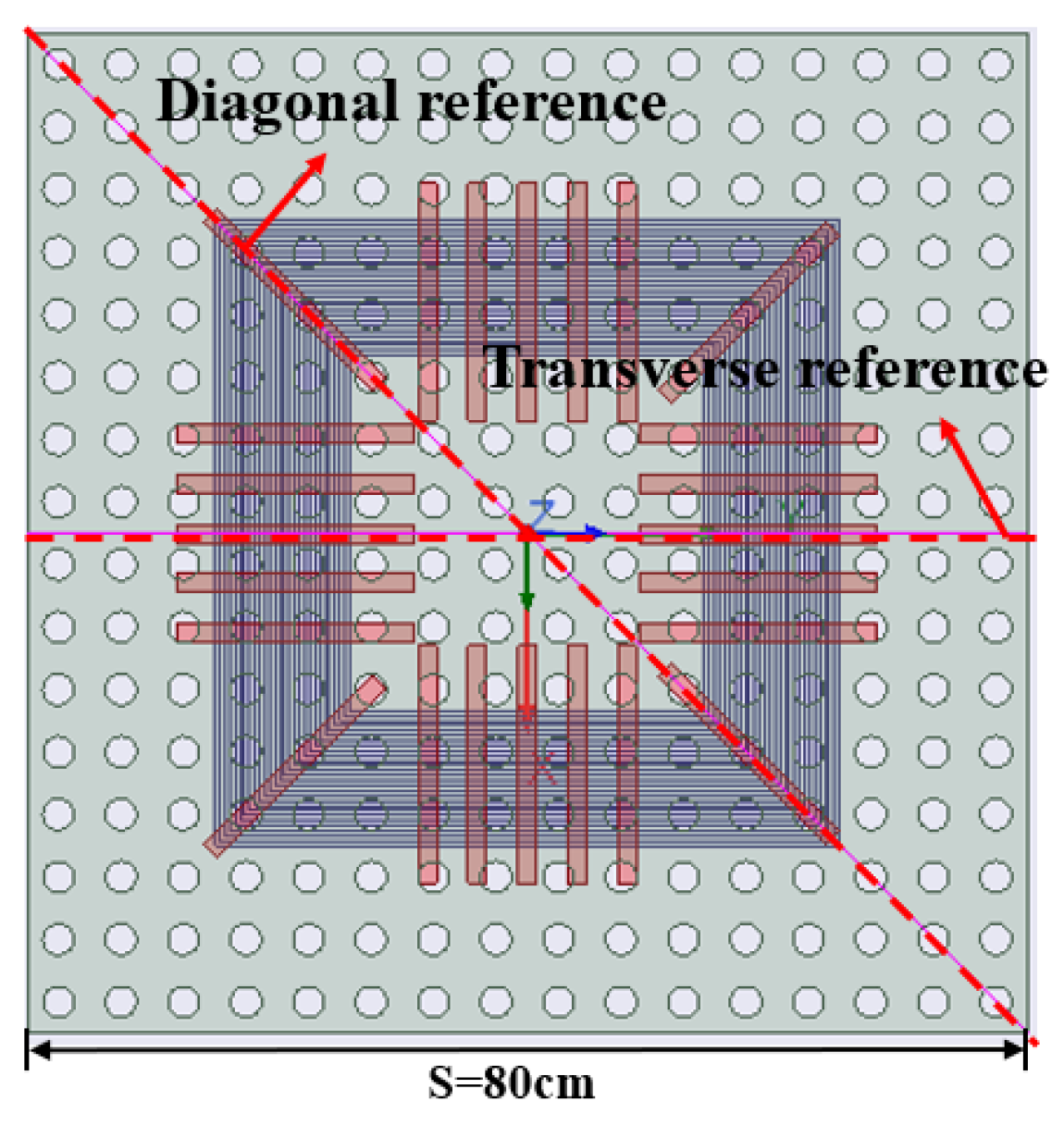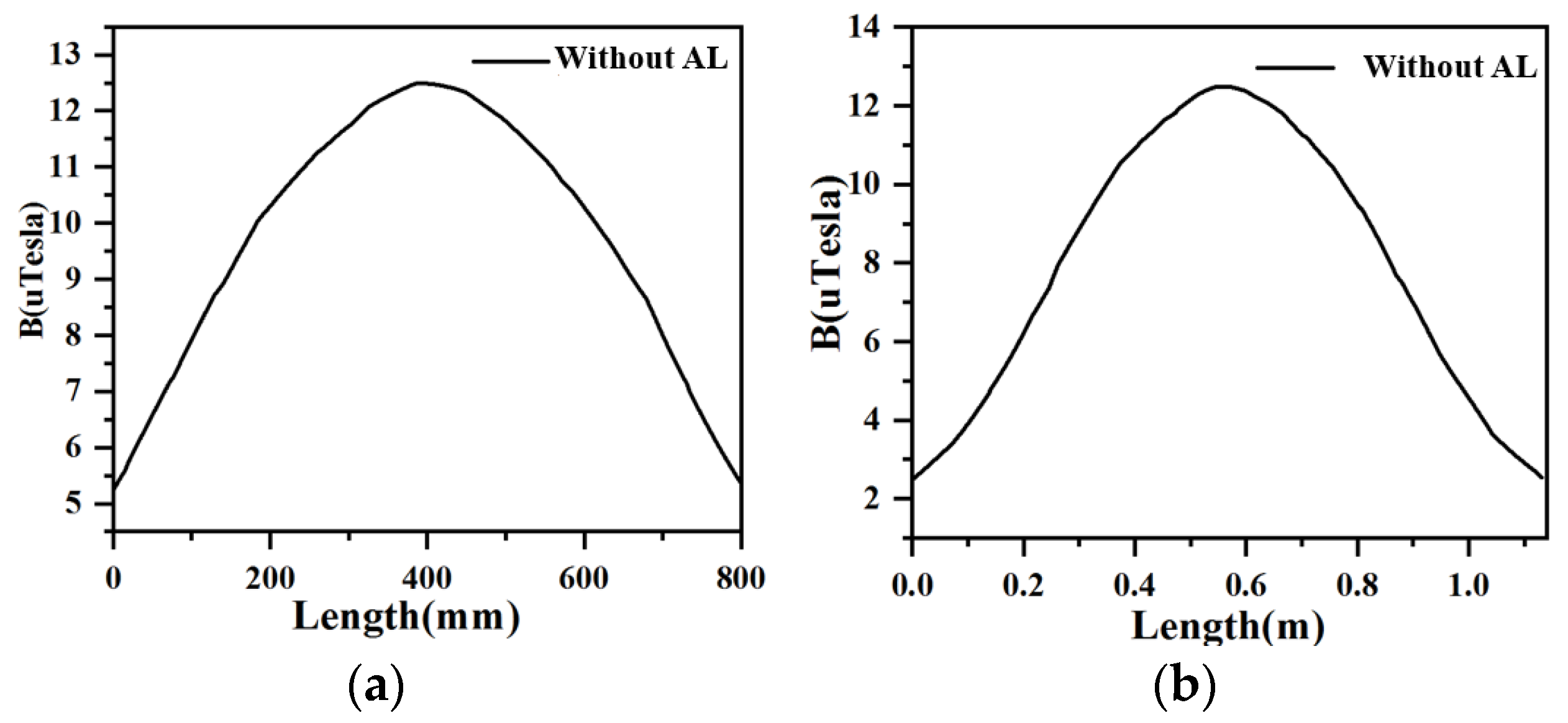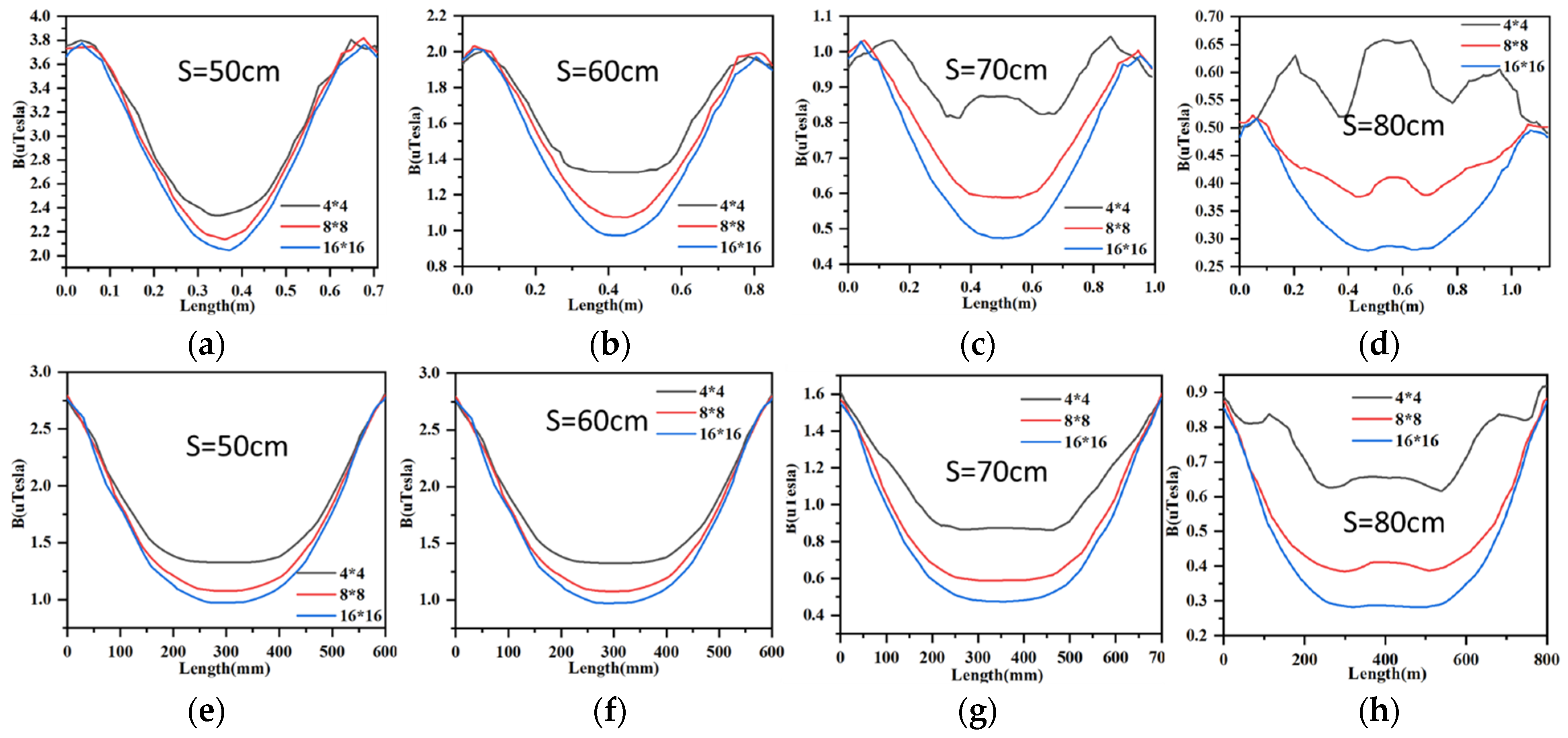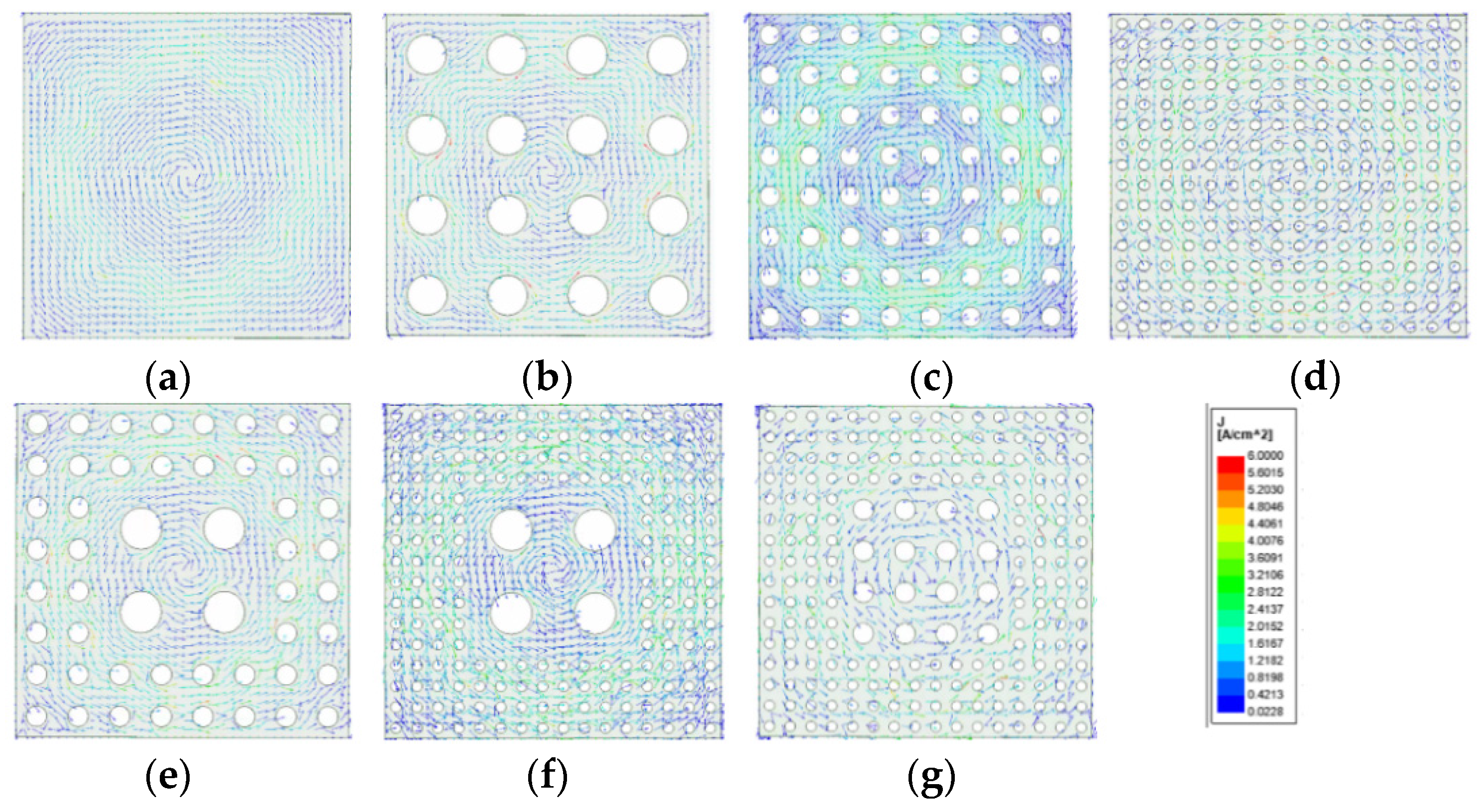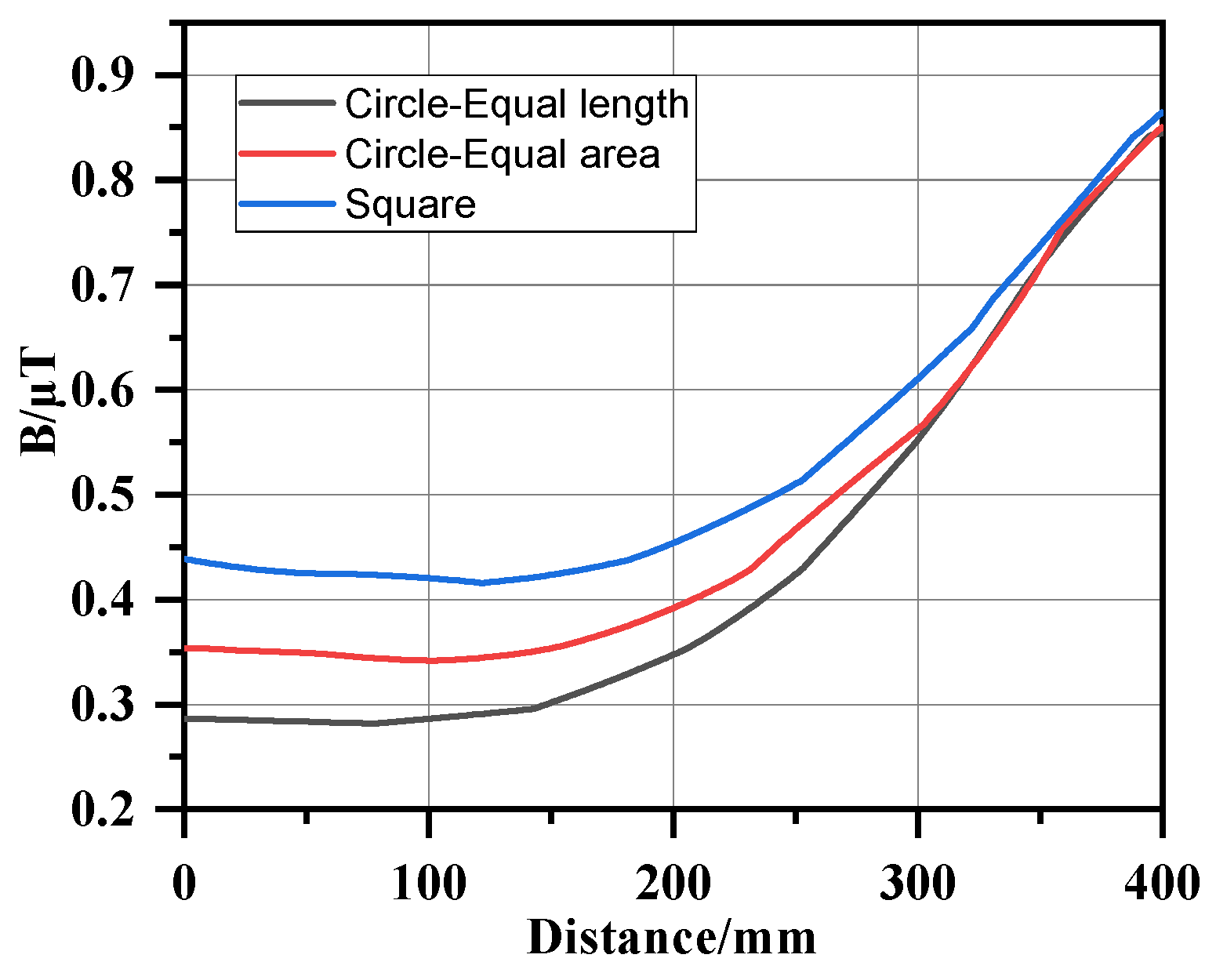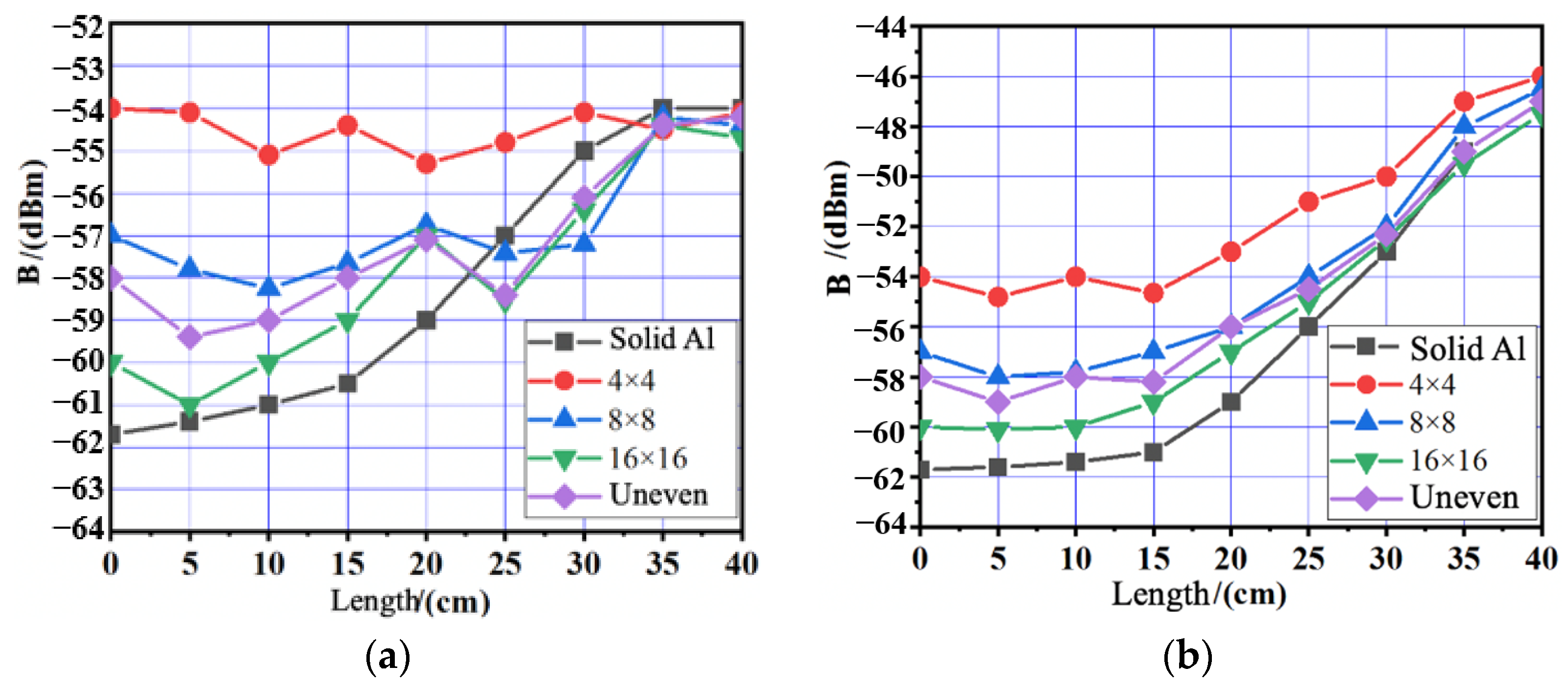3.1. Effect of Mesh Shape on System
For the EVs wireless charging system with shielding materials, in the process of simulation modelling, the model can be carried out according to the size and geometric parameters of the actual charging system, and then the impedance variation and transmission parameters of the system are analyzed. However, the EV wireless transmission systems work in the magnetic quasi-static field and can ignore the displacement current density. In the finite element simulation model, the correlation vectors all satisfy the Maxwell equation. Through the finite element simulation software, the electrical parameters of the coil after loading the shielded aluminium plate and the magnetic field intensity at any point in space can be obtained, which provides theoretical guidance for subsequent experiments. In this paper, Ansys Maxwell was used to simulate the wireless charging system without a shielding plate and the wireless charging system with a mesh plate.
Thanks to the inspiration of the electrostatic shielding of the metal mesh cover and the honeycomb shielding ventilation plate of the desktop computer, electromagnetic shielding can be achieved by drilling holes in the metal aluminium plate. It can not only achieve the EM shielding effect and reduce the impact on the transmission performance of the system, but it can also reduce the weight of the aluminium plate, avoid material waste, and has obvious advantages such as rebuilding, easy ventilation and heat dissipation. Therefore, this section is mainly based on the 3D electromagnetic simulation software, aiming at the electric vehicle wireless power transmission system model, and elaborates on the influence of the shape, size, thickness and loading position of the mesh aluminium plate on the charging system.
The magnetic induction intensity of the non-meshed aluminium plate electromagnetic shielding is shown in
Figure 4. The coils are square spiral coils with a side length L = 50 cm. The primary coil has 13 turns and the secondary coil has 11 turns, respectively. The coil is inlaid with magnetic core material PC40 to enhance the coupling strength of the coil. The two coils are perfectly aligned, and the original charging height is H = 20 cm. It can be found the solid aluminium plane has a great shielding effect. In addition, the coupling coefficient is 0.1645 in that case. Then, different forms of mesh aluminium plates are established, and their shapes and spatial magnetic field distribution diagrams are shown in
Figure 5. Taking the four shapes of triangle, square, hexagon and circle, respectively, all of which are distributed in an 8 × 8 array. It can be seen from the magnetic field distribution diagram that the magnetic field distribution is basically the same. The mesh shape of the aluminium plate has less effect on the electromagnetic distribution. Through further comparison of the electrical parameters of the coils, it can be found that the self-inductance and resistance are basically the same in the four cases, and almost the same results can be obtained. This conclusion is also demonstrated by the small differences in the coupling coefficients under the four forms. Because the circular mesh structure is easy to process, the structure is simple, and it has the characteristics of full symmetry, this paper selects the circular structure of the mesh aluminium plate to analyze and discuss the electromagnetic shielding of the electric vehicle wireless transmission system.
Figure 6 represents different mesh aluminium plates near the receiver array structure side shielding surface magnetic field distribution of the figure shows that due to the eddy current effect, the structure of various magnetic fields are present on the surface of the aluminium ring distribution of more uniform solid aluminium plate distributions, and in 4 × 4 mesh aluminium plates, due to large aperture the hole edge part of the magnetic field through the mesh forms a magnetic field with larger leakage. When the aperture of the aluminium plate is denser, the magnetic field distribution is closer to the aluminium plate. Therefore, it can be seen from the simulation diagram that when an aluminium plate of the same volume is used, a solid aluminium plate has the best shielding effect because it can reduce the transmission of the magnetic leakage field. However, from the perspective of the weight of the shielding body and its influence on transmission efficiency, a detailed analysis of the aluminium plate’s mesh array structure is still needed.
3.2. Effect of Mesh Aluminium Plate Size on System
Firstly, the influence of different sizes of mesh aluminium plates is analysed. The schematic diagram of the structure is shown in
Figure 7. It is assumed that the thickness of the mesh aluminium plate is t = 2 mm and the distance from the coil is d = 50 mm. Assuming that the coupling coils are all in a resonance state, when the size of the aluminium plate S increases from 50 cm to 100 cm, the changing relationship of the self-induction, resistance, coupling coefficient and transmission efficiency of the coupling coil is shown in
Figure 8.
k represents the coupling coefficient between the coils (the ratio of the mutual inductance between two coils to the product of their self-inductance). It can be seen from the figure that with the increase of the size of the aluminium plate, the influences of the transmitting coil and receiving coil of the reticulated aluminium plate with different array structures tend to be the same, that is, the inductance shows a downward trend, while the resistance changes slightly. The coupling coefficient and transmission efficiency of the system also decreases gradually with the increase of the size, mainly because the larger the mesh size of the aluminium plate, the obstruction effect on the coupling coil magnetic field will increase, thus affecting the mutual coupling between the transmitting coil and the receiving coil. However, when the size of the aluminium plate increases to 1.6 times of coil size (80 cm), the decreasing trend of transmission efficiency of the system gradually slows down. Compared with the 8 × 8 and 16 × 16 array mesh aluminium plate structures, the 4 × 4 mesh structure has the least influence on the transmission efficiency of the system. In conclusion, the size of the mesh of the aluminium plate has a significant influence on transmission performance, and the denser the mesh, the greater the influence on transmission efficiency, but when the size increases to a certain extent, the size of mesh has little influence on transmission efficiency.
To further study the electromagnetic shielding effect of different array meshed aluminium plates on WPT systems, the magnetic field intensity of the receiver is simulated and analysed. Considering the symmetry of the coupling mechanism and the mesh aluminium plate, two reference lines are selected here: transverse and diagonal reference lines, as shown in
Figure 9. The electromagnetic field intensity of transverse and diagonal reference lines can be obtained by simulation, which can be used to characterize the electromagnetic shielding effect of the meshed aluminium plate.
When the EVs’ wireless charging system is not loaded with mesh aluminium plate for electromagnetic shielding, simulation and comparative analysis are conducted on the magnetic fields of the transverse and diagonal reference lines at different heights. Here, S = 80 cm, and the magnetic induction intensity of the reference line at the receiving end varies with the length, as shown in
Figure 10. If the current flowing into the coupling coil is 1 A, it can be found when the distance between the reference line and the coil is from 10 cm to 50 cm, the magnetic field intensity decreases sharply with the increase of the distance. When the height is 50 cm, the magnetic induction intensity on the reference line changes little with the length. In general, for the WPT systems without shielding, the magnetic induction intensity changes in a “peak shape”, the magnetic field in the middle is the largest, and the magnetic field on both sides is relatively small, because the coupling coil can be equivalent to a multi-turn coil, and according to the magnetic field superposition theorem, the magnetic field in the middle is the strongest.
Figure 11 shows the variation of magnetic induction intensity of transverse and diagonal reference direction lines with the size of the meshed aluminium plate. It is assumed that the distance between the meshed aluminium plate and the coil is D = 50 mm, and the distance between the two reference lines and the meshed aluminium plate is 10 cm. In the actual electric vehicle wireless transmission system, the practicality and feasibility of the shielding body should be considered, and the size of the aluminium plate should not be too large. Therefore, when S changes from 50 cm to 80 cm, the change of magnetic field strength of the reference line is selected. As can be seen from the figure, compared with the unshielded body, the mesh aluminium plate can effectively reduce electromagnetic leakage. It is worth noting that the electromagnetic leakage at the centre of the reference line is effectively suppressed, and the surrounding magnetic field is also greatly reduced. The magnetic induction intensity is “sagging”, and the general trend is small in the middle and large on both sides. This is because of the presence of mesh aluminium plate, there will be an edge effect; that is, magnetic field lines will gather at the edge of the shielding layer, generating a strong electromagnetic field. With the increase of mesh aluminium plate size, the shielding effect is gradually better, and the edge effect is gradually weakened. When the mesh aluminium plate size is small, compared with the 4 × 4 mesh array structure, the electromagnetic shielding effect of 8 × 8 and 16 × 16 mesh structure tends to be the same. However, when the size of the meshed aluminium plate increases, due to the large mesh aperture of the 4 × 4 array structure, more magnetic field lines emanate from the mesh, resulting in the slow enhancement of the magnetic field at the centre. Compared with the 4 × 4, 8 × 8 structure, the 16 × 16 array structure has more dense mesh, the most serious reduction in efficiency, and the effect is like the aluminium plate. Therefore, the transmission performance of electric vehicle wireless transmission systems is also affected the most.
In conclusion, the size of the mesh aluminium plate has a great influence on the transmission performance of the wireless transmission system, but when the size of the mesh aluminium plate increases to a certain value, it almost has no influence on the transmission efficiency. Moreover, the larger the mesh aluminium plate size, the better the electromagnetic shielding effect, but at the same time, there is an edge effect, resulting in a strong magnetic field around the aluminium plate. For aluminium plates with different mesh structures, the denser the mesh, the better the shielding effect, but the greater the influence on the transmission performance of the system. In practical application, the large size of the aluminium plate not only affects the transmission performance of the system, but also increases the volume and weight of the shield, which brings challenges to the practical application of electric vehicle wireless transmission system. From the above analysis, it can be seen that the mesh aluminium plate with side length S = 80 cm can meet the demand of transmission efficiency. When the size continues to increase, the performance of the system remains basically unchanged, and it has a good shielding effect on electromagnetic leakage. Therefore, the mesh aluminium plate with a side length of 80 cm can be selected to better meet the needs of practical applications.
Figure 12 shows the current vector diagrams of different shielded aluminium plates. According to the above theoretical analysis, the changing magnetic field will induce the eddy current on the shielding aluminium plate, and the magnetic field generated by the eddy current lags 180° behind the original magnetic field, so it can inhibit the original magnetic field. It can be seen from the simulation current vector diagram of solid aluminium plate and mesh aluminium plate that the eddy current is mainly concentrated in an annular region. In this region, due to the presence of the mesh, the cross-sectional area of the loop is reduced, which leads to the increase of loop resistance and the decrease of induced current, and relatively weakens the shielding effect of the aluminium plate. By comparing the induced current vector diagrams of 4 × 4, 8 × 8 and 16 × 16, it can be found that the 4 × 4 mesh almost completely cuts off the main loop of the induced current, so the shielding effect of the aluminium plate with a 4 × 4 mesh structure is the least ideal. The 8 × 8 and 16 × 16 mesh structures weaken the eddy current in turn, and the shielding effect is gradually enhanced. The same phenomenon also exists for the non-uniform mesh aluminium plate. The magnetic field near the coil axis and away from the axis is affected by the central and peripheral mesh conditions of the aluminium plate, respectively. In terms of shielding effect, 4 × 4/8 × 8 (centre 4 × 4 edge 8 × 8 perforation) < 4 × 4/16 × 16 < 8 × 8/16 × 16, and all three are weaker than solid aluminium plate and 16 × 16 mesh structure.
A series of simulation studies were also carried out to analyze the impedance changes and transmission characteristics of different mesh arrays, as shown in
Table 1. According to the results, the influence of composite mesh on electrical parameters and transmission characteristics is between the uniform mesh, and the change is small, which will not be described in detail here. Compared with the aluminium plate with a uniform mesh array structure, the aluminium plate with non-uniform mesh can achieve a good shielding effect of the electromagnetic field in the target area through mesh density design. In a word, the denser the mesh, the better the shielding effect of the aluminium plate. Through the unequal design of the mesh array, the electromagnetic shielding effect of the aluminium plate can be flexibly adjusted.
The guidelines issued and updated by the International Commission for Non-Ionizing Radiation Protection (ICNIRP) to limit exposure to time-varying electric and magnetic fields are aimed at the maximum magnetic induction intensity within a space. Therefore, the leakage field in the central area of the shield plate is far less than the standard if the leakage field around the shield meets the standard. Based on this situation, this article considers using a large mesh in the middle and a small mesh around it to weaken the eddy current in the central area of the aluminium plate without changing the maximum leakage magnetic induction. This design can reduce the impact on efficiency while taking into account shielding performance.
3.4. The Final Design and Experiment
Figure 14 shows the mesh aluminium plates of four different array structures used in the experiment, whose sizes are the same as the simulation Settings. The side length of the mesh aluminium plate is set as S = 80 cm, and the thickness is set as t = 2 mm when aluminium plates with different structures are placed in the wireless transmission system of electric vehicles and the distance from the transmission coil is 5 cm.
Figure 15 shows the EVs wireless charging experimental platform. The whole system is composed of the transmitting side (DC power supply, full-bridge inverter, signal generator), the resonant coupling mechanism (transmitting coil, receiving coil, primary and secondary side compensation capacitor) and the receiving side (rectifier, equivalent resistance load). The size of the coupling mechanism is consistent with the simulation settings. The transmission coils are square spiral structures, and the outermost edge length of the coils is 50 cm. The transmitting coil has 14 turns, the receiving coil has 13 turns, and the distance between the two coils is 20 cm. Ferrite material (PC40) is attached to the outside of the transmission coil to enhance the coupling strength between the two coils.
Table 2 shows the experimental parameters of the charging system without an aluminium plate. These electrical parameters are measured by the benefit and impedance analyser (MICROTEST 6379). When the shielding aluminium plate is not added, the working frequency of the electric vehicle wireless transmission system is 85 kHz. It can be seen that the experimental results are basically consistent with the simulation results, and the resonant compensation capacitance is 21.3 nF.
When aluminium plates of different structures are loaded into the wireless transmission system of electric vehicles, the resonant frequency of the coil will change due to the change of inductance. By tuning the wireless transmission system, the system will always be in a resonant state.
Figure 16 shows the comparison of measured and calculated transmission efficiency of electric vehicle wireless transmission systems under different aluminium plate structures. When the wireless transmission system is not shielded with an aluminium plate, the transmission efficiency is about 97.54%. It can be seen from the experimental results that when the system is loaded with a solid aluminium plate, the transmission efficiency of the system is less than 90%, while the mesh aluminium plate can reduce the impact on the transmission efficiency of the system, the efficiency is more than 90%. Among them, the 4 × 4 mesh aluminium plate has the least influence on the system. It should be noted that the influence of aluminium plate with non-uniform mesh on the transmission efficiency of the system is between uniform mesh, which is also consistent with the simulation analysis.
The transverse/diagonal magnetic field of the electric vehicle wireless transmission system is analyzed experimentally. It is assumed that the current of the receiving coil is always 1 A. Since the coupling mechanism is symmetrical, the magnetic fields on both sides of the coupling mechanism are equal to each other from the centre. Therefore, only measuring the magnetic field at one end can reflect the magnetic field suppression of the whole reference line. The magnetic field strength was measured by a spectrum analyzer and a near-field probe, which was 10 cm away from the receiving coil. The magnetic field distribution diagram is shown in
Figure 17 when the system is not equipped with a shielded aluminium plate. It can be seen from the figure that when the system is not equipped with the shielding material, the magnetic field at the centre is the strongest, and the magnetic field weakens rapidly as the test point moves outward, which is also consistent with the magnetic field size trend of the simulation of the unshielded aluminium plate in the preceding chapter.
Figure 18 is the receiving end of lateral/diagonal direction magnetic field size change curve for loading different structural aluminium electric vehicle wireless power transmission system, in which the near-field probe distance shield aluminium plate is 5 cm. The figure shows that when the charging system load shielding aluminium plate and the test point moves outward, different structures of the aluminium plate’s magnetic field are increasing overall. This is because the current generated by the eddy current effect on the aluminium plate is mainly concentrated in the outer annular region, which is consistent with the simulation law of the upper magnetic field, and the magnetic field reaches the highest at the outermost part of the aluminium plate due to the edge effect. In general, a solid aluminium plate has the best electromagnetic suppression effect, but the advantage is not obvious compared with other mesh aluminium plates. Compared with the case without an aluminium plate, the maximum attenuation of the magnetic field at the centre point is 26 dB when the mesh aluminium plate is loaded. When the test point is close to the outside, the screen effect of the mesh aluminium plate is better than that of the solid aluminium plate. Compared with the mesh aluminium plate of different structures, it can be seen that the denser the mesh, the better the shielding effect, while the aluminium plate of the non-uniform mesh structure is between the uniform aluminium plate, which can be flexibly adjusted by changing the distribution of the mesh. It is worth mentioning that, as can be seen from
Figure 18b, the diagonal direction reference line will pass through part of the mesh aluminium plate. Due to the influence of magnetic leakage, some magnetic fields will have high intensity and show a fluctuation state. The experimental results are also well demonstrated and consistent with the simulation analysis.

